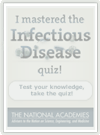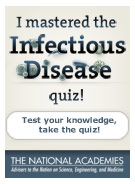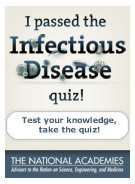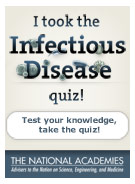
What You Need To Know About Infectious Disease
What do you know about infectious disease?
Which of the following can be treated with antibiotics?
-
Sorry, that’s incorrect.
Strep throat is a bacterial infection that can be treated with antibiotics. The common cold and influenza are both viral infections, which do not respond to antibiotics. Antivirals may be prescribed instead.
-
Correct!
Strep throat is a bacterial infection that can be treated with antibiotics. The common cold and influenza are both viral infections, which do not respond to antibiotics. Antivirals may be prescribed instead.
-
Sorry, that’s incorrect.
Strep throat is a bacterial infection that can be treated with antibiotics. The common cold and influenza are both viral infections, which do not respond to antibiotics. Antivirals may be prescribed instead.
-
Sorry, that’s incorrect.
Strep throat is a bacterial infection that can be treated with antibiotics. The common cold and influenza are both viral infections, which do not respond to antibiotics. Antivirals may be prescribed instead.
If you have strep throat, which of the following forms of medication can be used to effectively treat the infection?
-
Sorry, that’s incorrect.
Because strep throat is caused by a bacterium called Streptococcus pyogenes, it is treatable with antibiotics but not antivirals. Currently there is no vaccine available to prevent strep throat.
-
Correct!
Because strep throat is caused by a bacterium called Streptococcus pyogenes, it is treatable with antibiotics but not antivirals. Currently there is no vaccine available to prevent strep throat.
-
Sorry, that’s incorrect.
Because strep throat is caused by a bacterium called Streptococcus pyogenes, it is treatable with antibiotics but not antivirals. Currently there is no vaccine available to prevent strep throat.
-
Sorry, that’s incorrect.
Because strep throat is caused by a bacterium called Streptococcus pyogenes, it is treatable with antibiotics but not antivirals. Currently there is no vaccine available to prevent strep throat.
True or False: Growing evidence suggests that infections are behind many chronic diseases once thought to be caused by genetic, environmental, or lifestyle factors.
-
Correct!Growing evidence does suggest that infections are behind many chronic diseases once thought to be caused by genetic, environmental, or lifestyle factors, including peptic ulcers and cervical, liver, and gastric cancers.
-
Sorry, that’s incorrect.
Growing evidence does suggest that infections are behind many chronic diseases once thought to be caused by genetic, environmental, or lifestyle factors, including peptic ulcers and cervical, liver, and gastric cancers.
True or False: Infection with a pathogen (a disease-causing microbe) does not necessarily lead to disease.
-
Correct!
Infection occurs when viruses, bacteria, or other microbes enter your body and begin to multiply. Disease follows when the cells in your body are damaged as a result of infection, and signs and symptoms of an illness appear.
-
Sorry, that’s incorrect.
Infection occurs when viruses, bacteria, or other microbes enter your body and begin to multiply. Disease follows when the cells in your body are damaged as a result of infection, and signs and symptoms of an illness appear.
True or False: Thimerosal, a mercury-containing preservative that was used in some vaccines and other products, has been shown to present a risk to human health.
-
Sorry, that’s incorrect.
The use of thimerosal has been an object of controversy, with some arguing that the substance caused autism in children. However, extensive independent research has presented no convincing evidence of harm associated with the low levels of thimerosal previously present in vaccines.
-
Correct!
The use of thimerosal has been an object of controversy, with some arguing that the substance caused autism in children. However, extensive independent research has presented no convincing evidence of harm associated with the low levels of thimerosal previously present in vaccines.
Which are larger?
-
Correct!
Bacteria are 10 to 100 times larger than viruses.
-
Sorry, that’s incorrect.
Bacteria are 10 to 100 times larger than viruses.
True or False: Washing your hands with soaps that have residue-producing antibacterial products, such as those containing the chemical triclosan, have been proven to confer health benefits.
-
Sorry, that’s incorrect.
Washing with regular soap is considered the most important way to prevent disease transmission. Routine consumer use of residue-producing antibacterial products has no added benefit and may actually contribute to antibiotic resistance.
-
Correct!
Washing with regular soap is considered the most important way to prevent disease transmission. Routine consumer use of residue-producing antibacterial products has no added benefit and may actually contribute to antibiotic resistance.
Of the more than 1,700 known viruses, bacteria, and other pathogens that infect people, how many have come from animals?
-
Sorry, that’s incorrect.
More than half of the known pathogens that infect people have come from animals. Of the 37 new infectious diseases identified in just the past 30 years, two-thirds sprang from animals.
-
Sorry, that’s incorrect.
More than half of the known pathogens that infect people have come from animals. Of the 37 new infectious diseases identified in just the past 30 years, two-thirds sprang from animals.
-
Correct!
More than half of the known pathogens that infect people have come from animals. Of the 37 new infectious diseases identified in just the past 30 years, two-thirds sprang from animals.
Since the beginning of the 20th century, the number of people in the world has:
-
Sorry, that’s incorrect.
Since the beginning of the 20th century the number of people in the world has more than quadrupled—from 1.6 billion to nearly 7 billion—and world population is expected to rise to well over 9 billion by 2050.
-
Sorry, that’s incorrect.
Since the beginning of the 20th century the number of people in the world has more than quadrupled—from 1.6 billion to nearly 7 billion—and world population is expected to rise to well over 9 billion by 2050.
-
Correct!
Since the beginning of the 20th century the number of people in the world has more than quadrupled—from 1.6 billion to nearly 7 billion—and world population is expected to rise to well over 9 billion by 2050.
Thank you for taking our quiz.
Place this badge on your Facebook page to show your friends what you know about infectious disease.
Place this badge on your Facebook page to show your friends what you know about infectious disease.
OR, get a higher score to unlock a different badge.

Place this badge on your Facebook page to show your friends what you know about infectious disease.
OR, get a higher score to unlock a different badge.

Explore Other Topics
Disease Watchlist
Infectious Disease Defined
- Nerve Toxin
Also called neurotoxins, these refer to poisonous substances that cause damage to cells in the nervous system.


